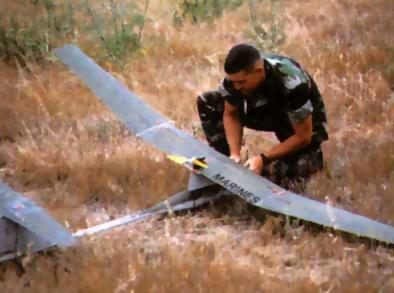مهدي كياني
کاربر فعال مهندسی هوافضا
AeroVironment FQM-151 Pointer
The FQM-151 Pointer is a very small hand-launched mini-UAV for real-time video surveillance. It is used by the U.S. Army and U.S. Marine Corps.
Development of the Pointer was begun by AeroVironment Inc. in 1986 as a private venture. Four vehicles were delivered to the U.S. Army in 1988 for test and evaluation, and a further 24 vehicles plus associated ground equipment were ordered for extended evaluation by Army and USMC in 1989. The first of these FQM-151A UAVs was delivered in early 1990.
The FQM-151A is of simple single-boom parasol sailplane configuration. It is powered by a 300 W electric motor, which uses either Li/SO2 primary or Ni/Cd rechargeable batteries. The air vehicle and GCU (Ground Control Unit) are each transported in backpacks weighing about 22 kg (50 lb) each. The Pointer is launched by hand, and lands on its belly after flown into a deep stall after engine shutdown. The FQM-151A can be equipped with either a colour or a night vision camera. The GCU consists of two units, the pilot having a display and control box to fly the vehicle using the video from the camera. The second operator has a hand-held display and VCR unit, and a microphone to record commentary on the observed video picture.
 [SIZE=-1]Photo: USMC[/SIZE] FQM-151A
[SIZE=-1]Photo: USMC[/SIZE] FQM-151A
In total, about 50 FQM-151A air vehicles were delivered to the U.S. armed services. Both the Army and Marine Corps used the Pointer in Operation Desert Storm in 1991. The mini-UAV was initially used to check the concealment of the U.S. forces, and later for damage assessment and battlefield surveillance. Since then, the FQM-151A has been upgraded with a GPS-based auto navigation unit to allow autonomous waypoint navigation and loiter functions. These features can significantly reduce the workload on the Pointer operators.
The Pointer system is gradually being replaced by the AeroVironment Puma and RQ-11 Raven UAVs. The former is a significantly upgraded Pointer, while the latter is a new smaller, lighter and more capable UAV system, which uses many Pointer components for easy transition.
Note: Data given by several sources show slight variations. Figures given below may therefore be inaccurate!
The FQM-151 Pointer is a very small hand-launched mini-UAV for real-time video surveillance. It is used by the U.S. Army and U.S. Marine Corps.
Development of the Pointer was begun by AeroVironment Inc. in 1986 as a private venture. Four vehicles were delivered to the U.S. Army in 1988 for test and evaluation, and a further 24 vehicles plus associated ground equipment were ordered for extended evaluation by Army and USMC in 1989. The first of these FQM-151A UAVs was delivered in early 1990.
The FQM-151A is of simple single-boom parasol sailplane configuration. It is powered by a 300 W electric motor, which uses either Li/SO2 primary or Ni/Cd rechargeable batteries. The air vehicle and GCU (Ground Control Unit) are each transported in backpacks weighing about 22 kg (50 lb) each. The Pointer is launched by hand, and lands on its belly after flown into a deep stall after engine shutdown. The FQM-151A can be equipped with either a colour or a night vision camera. The GCU consists of two units, the pilot having a display and control box to fly the vehicle using the video from the camera. The second operator has a hand-held display and VCR unit, and a microphone to record commentary on the observed video picture.

In total, about 50 FQM-151A air vehicles were delivered to the U.S. armed services. Both the Army and Marine Corps used the Pointer in Operation Desert Storm in 1991. The mini-UAV was initially used to check the concealment of the U.S. forces, and later for damage assessment and battlefield surveillance. Since then, the FQM-151A has been upgraded with a GPS-based auto navigation unit to allow autonomous waypoint navigation and loiter functions. These features can significantly reduce the workload on the Pointer operators.
The Pointer system is gradually being replaced by the AeroVironment Puma and RQ-11 Raven UAVs. The former is a significantly upgraded Pointer, while the latter is a new smaller, lighter and more capable UAV system, which uses many Pointer components for easy transition.
Specifications
Note: Data given by several sources show slight variations. Figures given below may therefore be inaccurate!
Data for FQM-151A:
Length1.83 m (6 ft)
Wingspan2.74 m (9 ft)
Weight4.3 kg (9.6 lb)
Speed80 km/h (43 knots)
Ceiling300 m (985 ft)
Mission Radius5 km (2.7 nm)
Enduranceprimary battieres: 1 hour
Rechargeable batteries: 20 min.
PropulsionElectric (samarium cobalt)
motor; 300 W
Length1.83 m (6 ft)
Wingspan2.74 m (9 ft)
Weight4.3 kg (9.6 lb)
Speed80 km/h (43 knots)
Ceiling300 m (985 ft)
Mission Radius5 km (2.7 nm)
Enduranceprimary battieres: 1 hour
Rechargeable batteries: 20 min.
PropulsionElectric (samarium cobalt)
motor; 300 W


